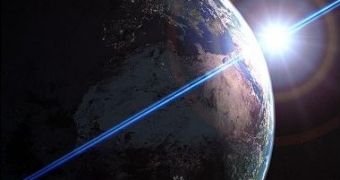It may seem strange to some of us but, in fact, it is easier to identify a planet as having the characteristics of our own than actually finding a planet with a size comparable to Earth. For example, there are currently about 270 known exo-planets, of which only a handful have rocky surfaces. By studying light scattered through their atmosphere, or reflected off the surface, researchers can tell whether the planet is habitable, has liquid water, an atmosphere, and even if life is present on it to some extent.
"We are looking for Earth-like planets in the habitable zone of their star, a band not too hot nor too cold for life to exist. We also want to known if there is water on these planets," says Penn State University researcher, Darren M. Williams. By simply taking the example of our own planet, we can conclude that for life to exist and evolve, an exo-planet must have habitable temperatures for long periods of time and extensive liquid water reserves.
The orbital distance of the planet around its parent star can be easily calculated by observing the interactions between light and the molecules present in the atmosphere. If liquid water is present on the surface, for example, it is but certain that water vapor should exist in the atmosphere. University of Hawaii associate professor of geobiology, Eric Gaidos argues that the best way to learn to identify water on the surface of a distant planet is to study the reflective properties of water on bodies closer to it.
"A planet like Venus, with a dense atmosphere, will scatter the sunlight in all directions. If you look at Venus in phase, when it is full, it is brightest and when it is crescent, it is faintest," explains Williams. When the planet is in a full phase, the water surface would look much darker than the surrounding land features; however, while in crescent phase, water would have maximum reflectivity, appearing extremely bright on the surface. Additionally, large amounts of water, such as those present on the Earth's surface, would show up as optical and infrared signatures in the spectral lines of the planet when observed over long periods of time.
"We are going to look at the planets for a long time. They reflect one billionth of one ten billionth of their sun. To gain enough light to see a dot requires observation over two weeks with the kinds of telescopes we are imagining. If we stare that long, unless the planet is rotating very slowly, different sides of the planet will come through our field of view. If the planet is a mix of water, we are going to see the mix travel around the planet," explains Williams.
By correlating the planet's phase with its brightness, researchers should be able to tell whether the planet has oceans or not, and decide on the most probable liquid to form the ocean, based on the temperatures experienced by the planet. Although this search looks pretty straightforward and simple enough, the truth is that we may have to wait another decade or so before telescopes become powerful enough to find such planets.
Until then, the ESA and Penn State University are working together on coordinating a mission using the Mars and Venus Express spacecrafts, that will take measurements of our planet in order to find out how the Earth really looks like through the eyes of an astronomer using only spectroscopic methods to study a distant body. "Any time that the Earth is in a crescent phase as viewed by a distant space vehicle, we should take advantage of the situation and look back at the Earth," says Williams.

 14 DAY TRIAL //
14 DAY TRIAL //